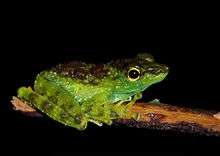Staurois tuberilinguis
Staurois tuberilinguis (common names: Borneo splash frog, green-spotted rock frog) is a species in the true frog family (Ranidae). It is widespread on Borneo.[1][2]
| Staurois tuberilinguis | |
|---|---|
 | |
| Adult seen along stream in Mt. Kinablu National Park | |
| Scientific classification | |
| Kingdom: | Animalia |
| Phylum: | Chordata |
| Class: | Amphibia |
| Order: | Anura |
| Family: | Ranidae |
| Genus: | Staurois |
| Species: | S. tuberilinguis |
| Binomial name | |
| Staurois tuberilinguis Boulenger, 1918 | |
| Synonyms | |
|
Rana tuberilinguis (Boulenger, 1918) | |
Description
Its snout-vent length is 27–31 mm (1.1–1.2 in) in males and 33–38 mm (1.3–1.5 in) in females. It has a markedly slender head with a pointed snout and a rather short fourth finger, distinguishing it from its relatives. Its vomer lacks teeth, and it has a lingual papilla. The eggs are unpigmented.[3]
Distribution
It is found in northern Borneo in Sabah and Sarawak (Malaysia), Brunei, and northeastern Kalimantan (Indonesia) to 2,000 m (6,600 ft) asl.[2]
A smaller relative, only known from the Crocker Range in Sabah (Malaysia), was described as Staurois parvus. Later, it was considered a junior synonym of S. tuberilinguis, but more recently it was confirmed to be distinct according to morphological and DNA sequence data.[2][3]
Habitat and ecology
This frog is diurnal and crepuscular and it is commonly found along the banks of small, rocky streams with clear water in primary rainforests. They can often be seen perched on rocks or other vegetation near water, usually around the rapids.[1] They breed in streams and the males vocalize during the day. Like other members of Staurois,[4][5] they use visual signalling to attract a mate.[1][6]
Conservation and threats
Deforestation by logging of forests and subsequent sedimentation and alteration of stream conditions are the primary threats to this species. It can be locally very common along streams but is declining in abundance. This species is found in Mt. Kinabalu and Gunung Mulu National Parks which are well protected. However, the mountains in Kalimantan need urgent and increased protection.[1]
References
- IUCN SSC Amphibian Specialist Group. 2018. Staurois tuberilinguis. The IUCN Red List of Threatened Species 2018: e.T58763A114924598. https://dx.doi.org/10.2305/IUCN.UK.2018-1.RLTS.T58763A114924598.en. Downloaded on 24 December 2018.
- Frost, Darrel R. (2015). "Staurois tuberilinguis Boulenger, 1918". Amphibian Species of the World: an Online Reference. Version 6.0. American Museum of Natural History. Retrieved 5 September 2015.
- Matsui, Masafumi; Mohamed, Maryati; Shimada, Tomohiko & Sudin, Ahmad (2007): Resurrection of Staurois parvus from S. tuberilinguis from Borneo (Amphibia, Ranidae). Zool. Sci. 24(1): 101–106. doi:10.2108/zsj.24.101
- Boeckle, Markus, Doris Preininger, and Walter Hödl (2009). "Communication in noisy environments I: acoustic signals of Staurois latopalmatus Boulenger 1887" (PDF). Herpetologica. 65 (2): 154–165. doi:10.1655/07-071R1.1.CS1 maint: uses authors parameter (link)
- Preininger, Doris, Markus Boeckle, and Walter Hödl (2009). "Communication in noisy environments II: Visual signaling behavior of male foot-flagging frogs Staurois latopalmatus" (PDF). Herpetologica. 65 (2): 166–173. doi:10.1655/08-037R.1.CS1 maint: uses authors parameter (link)
- Amphibians and Reptiles of Mount Kinabalu (North Borneo), R. Malkmus, U. Manthey, G. Vogel, P. Hoffmann and J. Kosuch. 2002. A.R.G . Gantner Verlag Kommanditgesellschaft, FL 9491 Ruggell
